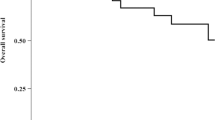Abstract
Purpose
The purpose of this study was to review outcomes of patients with advanced/metastatic pheochromocytoma/paraganglioma (PPGL) treated at our institution with Intensity-modulated radiotherapy (IMRT), describe the treatment outcomes, and determine predictors.
Methods
A retrospective study on patients with advanced/metastatic PPGL who received IMRT at Peking Union Medical College Hospital between 2014 and 2019. A total of 14 patients with 17 lesions were included in this study. Ultra-hypofractionated radiation therapy was used for 7 lesions in 5 patients, while hypofractionated radiation therapy was used for 8 lesions in 7 patients. 2 patients got conventional fractionated radiotherapy. Patients who received external beam radiation therapy were given a median total radiation dose of 74.4/130 Gy (BED10/3) in a median of 13 fractions.
Results
OS at 2 years was 78% for all patients. For lesions evaluated by RECIST response, at least stable disease of the target lesion was achieved in 94% and distant progression in 28.5%, with an average time to progression of 5.2 months. Patients with locally advanced primary tumors or recurred in situ (n = 8) achieved 100% local control, and none of them got recurrence or distant metastasis after radiotherapy at last follow-up (median 29 months). Of patients with catecholamine-related syndromes (n = 12), 91% of symptomatic lesions improved following radiation therapy and a more than 50% decline in catecholamines.
Conclusions
We have found hypofractionated IMRT effective as an additional therapy for patients with advanced primary tumors or recurrence in situ and not amenable to complete surgical resection.



Similar content being viewed by others
References
Lenders JW, Eisenhofer G, Mannelli M, Pacak K (2005) Phaeochromocytoma. Lancet 366(9486):665–675. https://doi.org/10.1016/S0140-6736(05)67139-5
Lenders JW, Duh QY, Eisenhofer G et al (2014) Pheochromocytoma and paraganglioma: an endocrine society clinical practice guideline. J Clin Endocrinol Metab 99(6):1915–1942. https://doi.org/10.1210/jc.2014-1498
Klöppel G, Hruban R. 2017 WHO classification of tumours of endocrine organs: Lyon: International Agency for Research on Cancer 2017
Hamidi O, Young WF Jr, Gruber L et al (2017) Outcomes of patients with metastatic phaeochromocytoma and paraganglioma: a systematic review and meta-analysis. Clin Endocrinol (Oxf) 87(5):440–450. https://doi.org/10.1111/cen.13434
De Filpo G, Cantini G, Rastrelli G et al (2022) Management and outcome of metastatic pheochromocytomas/paragangliomas: a monocentric experience. J Endocrinol Invest 45(1):149–157. https://doi.org/10.1007/s40618-021-01629-x
Hadoux J, Favier J, Scoazec JY et al (2014) SDHB mutations are associated with response to temozolomide in patients with metastatic pheochromocytoma or paraganglioma. Int J Cancer 135(11):2711–2720. https://doi.org/10.1002/ijc.28913
O’Kane GM, Ezzat S, Joshua AM et al (2019) A phase 2 trial of sunitinib in patients with progressive paraganglioma or pheochromocytoma: the SNIPP trial. Br J Cancer 120(12):1113–1119. https://doi.org/10.1038/s41416-019-0474-x
Fanciulli G, Di Molfetta S, Dotto A et al (2020) Emerging therapies in pheochromocytoma and paraganglioma: immune checkpoint inhibitors in the starting blocks. J Clin Med 10(1):88. https://doi.org/10.3390/jcm10010088[
Satapathy S, Mittal BR, Bhansali A (2019) Peptide receptor radionuclide therapy in the management of advanced pheochromocytoma and paraganglioma: a systematic review and meta-analysis. Clin Endocrinol (Oxf) 91(6):718–727. https://doi.org/10.1111/cen.14106[
Lin F, Rivero JD, Carrasquillo JA, Jha A, Pacak K (2019) Phase 2 trial of Lu-177-DOTATATE in inoperable pheochromocytoma/paraganglioma. J Clin Oncol 37(15):TPS4159–TPS4259
Breen W, Bancos I, Young WF Jr et al (2018) External beam radiation therapy for advanced/unresectable malignant paraganglioma and pheochromocytoma. Adv Radiat Oncol 3(1):25–29. https://doi.org/10.1016/j.adro.2017.11.002
Vogel J, Atanacio AS, Prodanov T et al (2014) External beam radiation therapy in treatment of malignant pheochromocytoma and paraganglioma. Front Oncol 4:166. https://doi.org/10.3389/fonc.2014.00166
Fishbein L, Bonner L, Torigian DA et al (2012) External beam radiation therapy (EBRT) for patients with malignant pheochromocytoma and non-head and -neck paraganglioma: combination with 131I-MIBG. Horm Metab Res 44(5):405–410. https://doi.org/10.1055/s-0032-1308992
De Filpo G, Maggi M, Mannelli M, Canu L (2021) Management and outcome of metastatic pheochromocytomas/paragangliomas: an overview. J Endocrinol Invest 44(1):15–25. https://doi.org/10.1007/s40618-020-01344-z
Eisenhauer EA, Therasse P, Bogaerts J et al (2009) New response evaluation criteria in solid tumours: revised RECIST guideline (version 1.1). Eur J Cancer 45(2):228–247. https://doi.org/10.1016/j.ejca.2008.10.026
Cox JD, Stetz J, Pajak TF (1995) Toxicity criteria of the Radiation Therapy Oncology Group (RTOG) and the European Organization for Research and Treatment of Cancer (EORTC). Int J Radiat Oncol Biol Phys 31(5):1341–1346. https://doi.org/10.1016/0360-3016(95)00060-C
Batchu S, Hakim A, Henry OS et al (2022) Transcriptome-guided resolution of tumor microenvironment interactions in pheochromocytoma and paraganglioma subtypes. J Endocrinol Invest 45(5):989–998. https://doi.org/10.1007/s40618-021-01729-8
Funding
This research was funded by the grant from the Ministry of Science and Technology of China, grant number 2016YFC0105207, and CAMS Innovation Fund for Medical Sciences (CIFMS) 2021-I2M-C&T-B-002, 2017-I2M-1–001.
Author information
Authors and Affiliations
Corresponding author
Ethics declarations
Conflict of interest
The authors declare that there is no conflict of interest that could be perceived as prejudicing the impartiality of this review.
Compliance with ethics requirements
All procedures performed in studies involving human participants were in accordance with the ethical standards of the institutional and/or national research committee and with the 1964 Helsinki declaration and its later amendments or comparable ethical standards.
Statement of human and animal rights
All procedures were approved by Peking Union Medical College Hospital Ethics Committee (Approval No. S-K 1886), and the document (scanned version in Chinese) is uploaded to the attachment.
Informed consent
Informed consent was obtained from all individual participants included in the study.
Additional information
Publisher's Note
Springer Nature remains neutral with regard to jurisdictional claims in published maps and institutional affiliations.
Rights and permissions
Springer Nature or its licensor holds exclusive rights to this article under a publishing agreement with the author(s) or other rightsholder(s); author self-archiving of the accepted manuscript version of this article is solely governed by the terms of such publishing agreement and applicable law.
About this article
Cite this article
Gu, Z., Hu, K., Liang, Y. et al. Favorable outcome in advanced pheochromocytoma and paraganglioma after hypofractionated intensity modulated radiotherapy. J Endocrinol Invest 46, 477–485 (2023). https://doi.org/10.1007/s40618-022-01908-1
Received:
Accepted:
Published:
Issue Date:
DOI: https://doi.org/10.1007/s40618-022-01908-1




